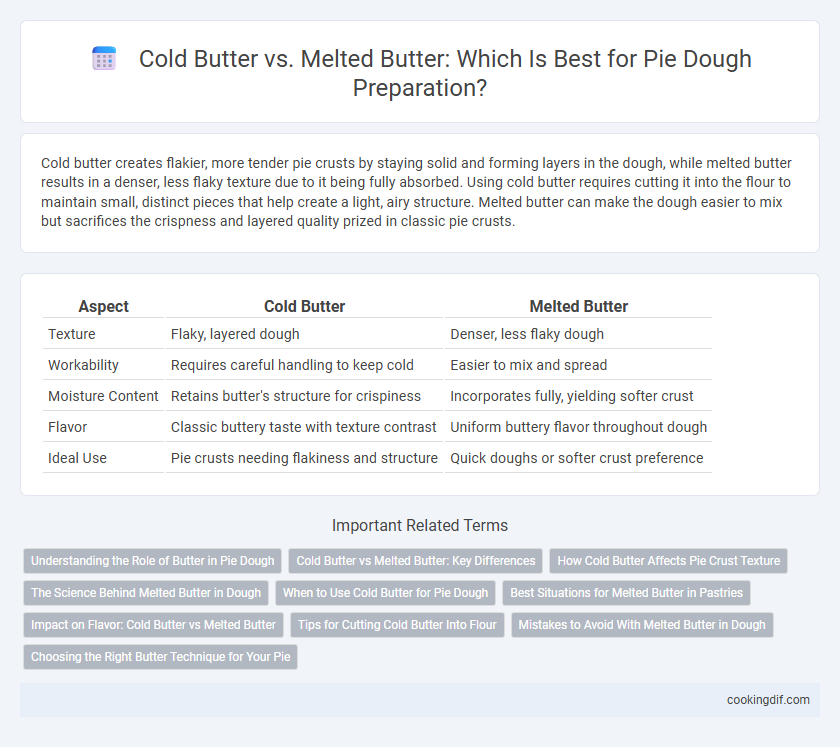Cold butter creates flakier, more tender pie crusts by staying solid and forming layers in the dough, while melted butter results in a denser, less flaky texture due to it being fully absorbed. Using cold butter requires cutting it into the flour to maintain small, distinct pieces that help create a light, airy structure. Melted butter can make the dough easier to mix but sacrifices the crispness and layered quality prized in classic pie crusts.
Table of Comparison
| Aspect | Cold Butter | Melted Butter |
|---|---|---|
| Texture | Flaky, layered dough | Denser, less flaky dough |
| Workability | Requires careful handling to keep cold | Easier to mix and spread |
| Moisture Content | Retains butter's structure for crispiness | Incorporates fully, yielding softer crust |
| Flavor | Classic buttery taste with texture contrast | Uniform buttery flavor throughout dough |
| Ideal Use | Pie crusts needing flakiness and structure | Quick doughs or softer crust preference |
Understanding the Role of Butter in Pie Dough
Cold butter creates flaky layers in pie dough by releasing steam during baking, which helps separate the dough into delicate, tender flakes. Melted butter, when used, blends fully with the flour, resulting in denser, less flaky crusts due to the lack of steam pockets. Understanding butter's temperature impact is crucial for achieving the desired texture and structural integrity in pie crusts.
Cold Butter vs Melted Butter: Key Differences
Cold butter creates a flakier, more tender pie crust by forming small pockets of steam during baking, which helps layers separate and adds texture. Melted butter, when mixed into dough, produces a denser and less flaky crust because it fully incorporates fat, eliminating these steam pockets. Using cold butter is essential for achieving the classic, crumbly texture prized in traditional pie crusts, while melted butter suits recipes where a softer, more cookie-like crust is desired.
How Cold Butter Affects Pie Crust Texture
Cold butter in pie dough creates a flaky texture by forming small, solid fat pockets that steam and separate the layers during baking. These pockets prevent the flour from fully hydrating, resulting in a tender yet crisp crust. In contrast, melted butter blends completely into the dough, producing a denser, less flaky texture.
The Science Behind Melted Butter in Dough
Melted butter in dough changes its fat distribution, resulting in a denser, chewier texture due to the fat coating flour proteins before hydration. This process inhibits gluten formation more thoroughly than cold butter, which creates flakier layers by solid fat pockets. Understanding this distinction helps bakers control pie crust texture for desired outcomes.
When to Use Cold Butter for Pie Dough
Cold butter is essential for creating flaky pie dough, as it helps form small pockets of steam during baking that result in a tender, layered crust. Use cold butter when preparing pastry for fruit pies or quiches requiring a crisp, delicate texture. Keeping the butter cold ensures minimal gluten development, preventing a tough or chewy crust.
Best Situations for Melted Butter in Pastries
Melted butter is ideal for pastries that require a tender, dense texture such as brownies, bars, and certain pie crusts where flakiness is less critical. Its liquid form integrates smoothly with sugar and dry ingredients, promoting even moisture distribution and a softer crumb. Using melted butter enhances richness and intensifies flavor, making it perfect for rich, moist pie doughs like chocolate or nut-based crusts.
Impact on Flavor: Cold Butter vs Melted Butter
Cold butter in pie dough creates tender, flaky layers by releasing steam during baking, which enhances the buttery flavor and texture. Melted butter blends fully into the dough, producing a denser crust with a richer, uniform flavor but less flakiness. Choosing cold butter preserves the traditional pie crust taste and texture, while melted butter intensifies flavor at the expense of crispness.
Tips for Cutting Cold Butter Into Flour
Cutting cold butter into flour creates a flaky pie crust by preventing the butter from fully melting, which forms pockets of steam during baking. Use a pastry cutter or two knives to evenly distribute small butter pieces throughout the flour, enhancing dough texture and preventing overworking. Chill both the butter and flour beforehand to maintain cold butter temperature, ensuring optimal dough consistency and flakiness.
Mistakes to Avoid With Melted Butter in Dough
Using melted butter in pie dough can lead to a greasy, dense texture because it coats flour proteins unevenly, preventing proper gluten development. Avoid incorporating melted butter at high temperatures to prevent over-softening the dough, which results in poor structure and difficulty handling. Chilling the dough after mixing with melted butter is crucial to maintain firmness and ensure a flaky, tender crust.
Choosing the Right Butter Technique for Your Pie
Cold butter creates flaky, tender pie crusts by maintaining small, solid pieces that steam and separate dough layers during baking. Melted butter produces a denser, chewier texture ideal for crumbly or cookie-like crusts, as it fully integrates into the dough. Selecting cold butter suits classic flaky pies, while melted butter works best for sturdier, rich crusts.
Cold butter vs melted butter for dough preparation Infographic

 cookingdif.com
cookingdif.com